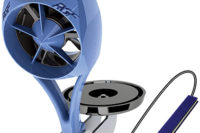While not often addressed, the air handler in an HVAC system has a significant role to play. When installed and maintained correctly, this piece of the puzzle is an ally of comfort and IAQ. Used incorrectly, however, it can lead to a new story to tell of air handler woes, discomfort, and poor IAQ.
Air Handler Placement
The primary role of the air handler is to evenly distribute hot and cold air throughout the home or commercial structure. As a result of its function,
the air handler also helps remove humidity.
“It is to act as the power plant to what is felt inside the home,” said Mike Antonucci, manager of Advanced-Air in Fort Myers, Florida. “It needs to be set up properly to distribute air at a volume great enough to cool a home to a set point while still allowing as much time as possible to draw out humidity. As long as it is attached to a good duct system with a house having a decent envelope, it all comes together.”
Depending on the age of a home or building, the condition of the envelope can vary greatly. These varied conditions can shorten an air handler’s life, reduce its efficiency, or both. According to Antonucci, where the air handler is installed has a profound effect on its performance.
“Usually, a unit in a conditioned space is optimal,” he said. “If it is in an attic or garage, it has to work harder, and it condensates more on the outside of the cabinet with a heat load being placed on it while it is trying to operate. If it is installed as a vertical in a closet inside conditioned space, it doesn’t need to overcome the heat load of a 120+ degree attic, and it will not condensate on the outside of the cabinet.”
Maintenance and IAQ
As with other HVAC equipment, air handlers do require maintenance to keep them running at optimal efficiency. According to Jim Crist, an HVAC specialist for U.S. Heating and Air in Denton, Maryland, cleaning and maintenance of the inner coils is an important step to help eliminate mold and mildew.

COIL MAINTENANCE: Keeping the coil clean is important and something that customers should likely be aware of and address along with their HVAC contractors.
“It is also necessary to wipe down the blower motor and interior cabinet, always ensuring the condensate drains are functioning and are not clogged,” he said. “Technicians should perform amp draws on motors and heat banks, as well as an overall system operation check at the end of the process.”
Antonucci agreed that it is important to clean the blower and the coil. He also suggested that technicians drop drain tablets in the drain pain and that they clear the drain line.
“Make sure the float switch works, make sure the heat works, and make sure the plenums do not leak,” he said.
The maintenance steps taken for air handlers often pair well with different IAQ options to further improve air quality. Keeping the coil clean is important and something that customers should likely be aware of and address with their HVAC contractors.
“We advise the homeowner to install RGF’s twin UV light system to help keep the coil clean,” said Douglas S. Lindstrom, owner of Lindstrom Air Conditioning & Plumbing, Pompano Beach, Florida. “The No. 1 failure of an air handler is a restricted coil due to the homeowner not changing the coil enough and not using a MERV-type filter. If you install RGF’s twin UV light system inside the unit and RGF’s REME HALO® in the plenum, you have the best of both worlds.”
The product is a whole-home in-duct air purifier designed to eliminate sick building syndrome risks by reducing odors and air pollutants. According to RGF, it is effective against all three categories of indoor air pollutants — particulates, microbial, and gases.
Sterilization of air handlers is accomplished in three specific ways at U.S. Heating and Air, according to Crist. The first way is the installation of UV lights for the coil mildew reduction treatment. The company also offers air purifier filtration systems with a UV hydrogen function to kill microorganisms. There is a final sterilization fogging process that the company has become certified to perform for customers.
“It depends on the makeup of the coil as to what is used to sanitize,” said Antonucci. “There are a variety of cleaners on the market. We also provide access to our customers to purchase UV lights and indoor air quality products as well.”
Efficiency and Savings
When considering the efficiency and savings provided by air handlers, Antonucci cautioned that the biggest savings actually comes from the condenser and not the air handler.

MAKING CHOICES: Contractors can install just about any style of air handler asked for in a residential application, but they must bear in mind the efficiency levels reached when matched to condensers.
“That being said, air handlers need to be variable-speed with electronic valves to accommodate communicating systems,” he explained. “Basically, all air handlers are matched to condensers to perform to established ratings.”
With this in mind, his company installs just about any style asked for in a residential application.
“We do prefer to do variable-speed communicating systems, as they provide the best comfort control and cost savings,” said Antonucci.
Lindstrom agreed that variable-speed equipment will control the even airflow to each room. As for Crist, he also considers different motor types.
“Customers have the option of ECM and modulating time standard on/off blowers,” he said. “I push ECM blowers for optimization with a delay/off feature, allowing the motor to operate at a significantly lower speed but still deliver the comfortable air you have already paid to produce.”
Following some of these tips can help technicians improve their services and customers improve their efficiency and IAQ.
“Planting a few shade trees around the house wouldn’t hurt at all, either — especially during the heaviest loads of the day,” said Antonucci.







